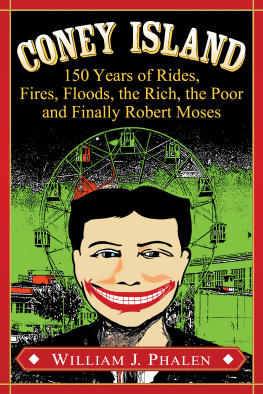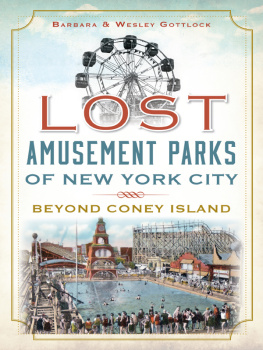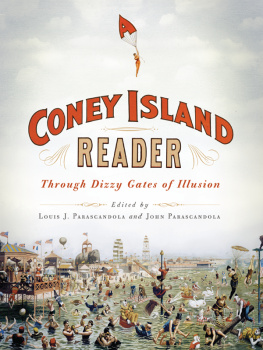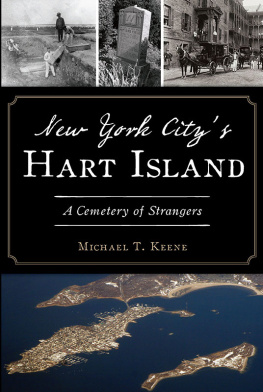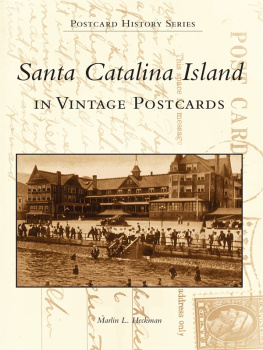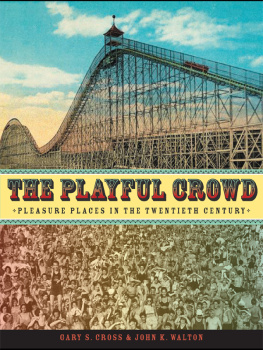
Also by WILLIAM J. PHALEN
AND FROM MCFARLAND
How the Telegraph Changed the World (2015)
The Consequences of Cotton in Antebellum America (2014)
American Evangelical Protestantism and European Immigrants, 18001924 (2011)
CONEY ISLAND
150 Years of Rides, Fires, Floods, the Rich, the Poor and Finally Robert Moses
William J. Phalen

McFarland & Company, Inc., Publishers
Jefferson, North Carolina
Maps by Susan A. McDermott
LIBRARY OF CONGRESS CATALOGUING DATA ARE AVAILABLE
BRITISH LIBRARY CATALOGUING DATA ARE AVAILABLE
e-ISBN: 978-1-4766-2373-3
2016 William J. Phalen. All rights reserved
No part of this book may be reproduced or transmitted in any form or by any means, electronic or mechanical, including photocopying or recording, or by any information storage and retrieval system, without permission in writing from the publisher.
Front cover image of photo illustration of George C. Tilyou by Susan A. McDermott
McFarland & Company, Inc., Publishers
Box 611, Jefferson, North Carolina 28640
www.mcfarlandpub.com
For my grandchildren,
Megan, Cassia, and Callan.
Special thanks to Mae Comito
whose knowledge of Coney Island
proves the value of oral history.
Preface
Amusement parks brought together the legacy of several 19th-century institutions. To quote a park manager of the time, If anything, the amusement park is the byproduct of the Midway or amusement section of the Exposition or Worlds Fairs, and virtually the opposite of the Exposition, Circus, County Fair, and Carnival.
As historians Robert Rydell and Rob Kroes put it, The [1893] Chicago fair with its park-like setting and popular Midway Plaisance opened the eyes of several entrepreneurs to the possibility of making their fortunes from perpetuating the legacy of commercialized pleasures found at the fair.
Amusement parks were also descendants of European pleasure gardens, most notably Copenhagens Tivoli Gardens and Londons Vauxhall. For the price of an admission ticket, Vauxhall, opened around 1660, allowed the lower classes access to leisure activities once only enjoyed by the elite. Tivoli, founded in 1843, expanded on the Vauxhall theme, adding cafes, theaters, a merry-go-round, and concerts.
In the United States, a number of parks came into existence before the Civil War. The difference in America was transportation. When the trolley or interurban rail lines reached a park, the rail company bought the land and transformed the park into an industrialized amusement zone. Some charged admission fees, and some did not; the primary goal, however, was to encourage ridership on the rail line, and the parks fulfilled an important economic function by serving as desirable destinations at the ends of traction company lines.
A key factor in the success of an amusement park was the fact that the patron was always in doubt as to whether he was the surveyor or the surveyed. Wandering from attraction to attraction, one was never far from being an object of fascination for others. Historian Kathy Peiss described the situation at Coney Island: The patrons were whirled through space and knocked off balance, their hats blown off, skirts lifted, senses of humor tried. The patrons themselves became the show, providing interest and hilarity to each other. Audience participation, the interaction of strangers, and voyeurism were incorporated.
Steeplechase was a prime example of an amusement park that liberated its patrons from Victorian decorum, from rigid codes of social conduct and propriety. Amusement parks thus became important targets for debate about modern urban culture. For some, the amusement park may have symbolized the democratic ideals of a melting pot society. But for others, such as the art critic James Huneker, the opposite was the case: In a word, it is not a question of restriction but of regulation, decency, good taste. And semi barbarism should not be allowed to go unchecked. Coney Island is a disgrace to our civilization. It should be abolished, and something else substituted.
The three major seaside Coney Island parksSteeplechase, Luna Park, and Dreamlandsurvived criticism because they combined popular modernity, mass consumption, and a new collective experience while also offering traditional entertainments such as dioramas, firework spectacles, and music and dance halls, as well as freak and girlie shows. As important, the crowds became involved in the partaking of food and drink to excess, social inversion, mockery, and a fascination with the supernatural and abnormal that provided psychological release for people who daily endured the rigors of scarcity, tedium, and the humiliation of authority.
Through the creative use of new technology, these resorts produced new ways of liberating the individual from boredom because of the speed and realism of new rides and spectacles. They offered an exciting encounter with continuous novelty that could fill sometimes lonely and empty livesif only briefly. And these resorts were incredibly successful. In 1910, Coney Island claimed 20 million visitors, a higher number than Disney theme parks could claim seventy years later.
Introduction
Coney Island is simply and basically a beachone that at times was the main attraction and, at other times, a backdrop to whatever was happening on the other parts of this small island at the bottom of Brooklyn, New York.
In the early 19th century, the beach attracted a few rabbit hunters and swimmers, usually from the neighboring town of Gravesend. As early as 1824, steps were taken to connect the island to the mainland by building a road across the two areas, facilitating carriage traffic from Brooklyn to the beach. As the reputation of the beach increased, it became obvious that horse-drawn carriages were not the ideal mode of transportation to the island, as they were too slow and too expensive. In 1847, steamships from Manhattan and northern Brooklyn began making scheduled trips, docking at the extreme western tip of the island, which became known as Nortons Point. By the Civil War, the beach was still the reason for visitors to make the sometimes arduous trip because the area east of Nortons Point (which would ultimately become West Brighton) had no attractions besides a dozen small hotels with ramshackle bathhouses, some chowder stands, and a few saloons.
Publicity began to create changes in the area in 1860 when the New YorkTimes reported, There is one cool spot that is healthy and invigorating which New Yorkers can resort to, and that is Coney Island.
With the end of the Civil War, the gentry began to have company enjoying the pleasures of Coney Island. Increased competition lowered the cost of traveling to the island, and continued newspaper stories prompted more and more people to make the journey. The wealthy, however, continued to congregate on the island, but to the east of the lower classes. In 1873, Austin Tobin opened the palatial Manhattan Beach Hotel. A New YorkTimes reporter said of the structure, Yesterday, one of the largest and best appointed appearing hotels in the country uprose out of the salt grass and sand, and so densely populated were its acres of piazzas and dining rooms that locomotion through them was a matter of slow and tedious difficulty. In 1874, the Brighton Beach hotel, another grand structure (although not as grand as the Manhattan Beach Hotel), was erected in an area which became known as Brighton Beach. This area was situated between Manhattan Beach to its east and West Brighton (or Coney Island) to its west. The three areas appealed to three types of patronsManhattan Beach to the gentry, Brighton Beach to the merely wealthy, and Coney Island (which included Nortons Point) to the working class.
Next page
